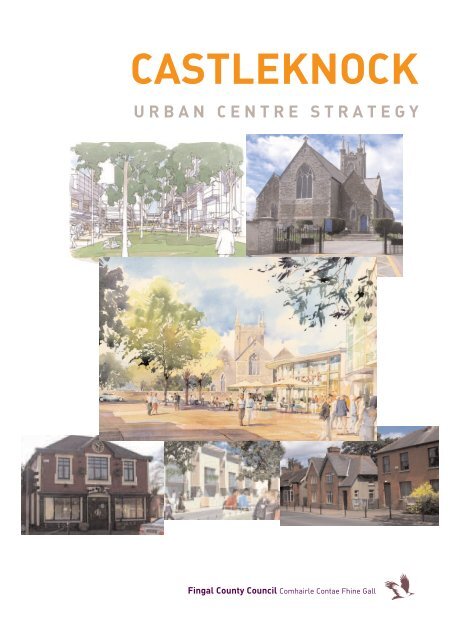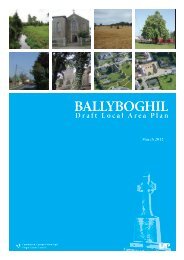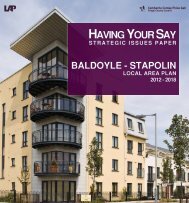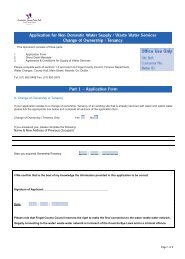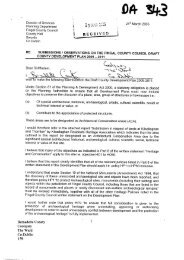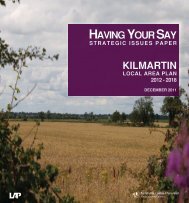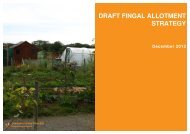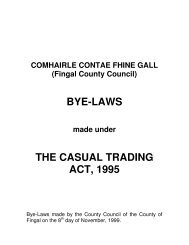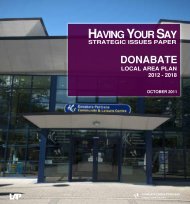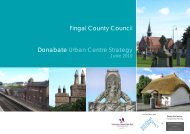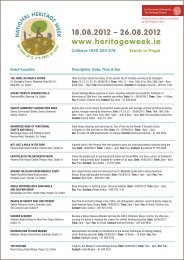Castleknock Urban Centre Strategy - Fingal County Council
Castleknock Urban Centre Strategy - Fingal County Council
Castleknock Urban Centre Strategy - Fingal County Council
Create successful ePaper yourself
Turn your PDF publications into a flip-book with our unique Google optimized e-Paper software.
CASTLEKNOCK<br />
URBAN CENTRE STRATEGY<br />
<strong>Fingal</strong> <strong>County</strong> <strong>Council</strong> Comhairle Contae Fhine Gall
CASTLEKNOCK<br />
URBAN CENTRE STRATEGY<br />
JUNE 2008<br />
DAVID O’CONNOR<br />
<strong>County</strong> Manager<br />
<strong>Fingal</strong> <strong>County</strong> <strong>Council</strong><br />
Comhairle Contae Fhine Gall<br />
This <strong>Urban</strong> <strong>Centre</strong> <strong>Strategy</strong> was presented to<br />
and noted by the <strong>Castleknock</strong>/Mulhuddart Area<br />
Committee on the 26 th June 2008.<br />
GILBERT POWER<br />
Director of Planning<br />
JOAN CAFFREY<br />
Senior Planner<br />
STEWART LOGAN<br />
Senior Executive Planner<br />
<strong>Fingal</strong> <strong>County</strong> <strong>Council</strong> ■ Planning Department ■ Grove Road ■ Blanchardstown
<strong>Fingal</strong> <strong>County</strong> <strong>Council</strong> Comhairle Contae Fhine Gall<br />
CONTENTS<br />
1 BACKGROUND & VILLAGE CONTEXT 1<br />
1.1 Development <strong>Strategy</strong> 1<br />
1.2 Consultation 1<br />
1.3 Physical Context 1<br />
1.4 Population Profile 2<br />
1.5 Movement 3<br />
1.5.1 Public Transport 3<br />
1.5.2 Road Network 3<br />
1.5.3 Walking & Cycling 3<br />
1.6 Existing Shopping and Services 4<br />
1.7 Heritage 5<br />
1.8 <strong>Fingal</strong> <strong>County</strong> Development Plan 2005-2011 8<br />
1.9 <strong>Fingal</strong> <strong>County</strong> Retail <strong>Strategy</strong> 10<br />
2 ASSESSMENT OF NEEDS OF THE VILLAGE 12<br />
2.1 Introduction 12<br />
2.2 Village Analysis 12<br />
2.2.1 Strengths 12<br />
2.2.2 Weakness and Constraints 12<br />
2.2.3 Key Opportunities to consolidate and enhance 13<br />
3 URBAN STRATEGY 15<br />
3.1 General 15<br />
3.2 Establishment of a Village Core 16<br />
3.2.1 Retail Provision 17<br />
3.3 Traffic 17<br />
3.3.1 Main Street 19<br />
3.4 Streetscape <strong>Strategy</strong> 19<br />
3.5 Public Space 21<br />
3.6 Protection of Existing Environment and Heritage 25<br />
3.7 Car Parking 26<br />
4 DESIGN & DEVELOPMENT STANDARDS 27<br />
4.1 Introduction 27<br />
4.2 Site Development Standards 27<br />
5 IMPLEMENTATION OF THE STRATEGY 31<br />
5.1 Implementation 31<br />
5.2 Role of the <strong>Urban</strong> <strong>Centre</strong> <strong>Strategy</strong> 31<br />
5.3 Financing Public Works 31<br />
APPENDIX 1 - Submissions to the public consultation. 35<br />
APPENDIX 2 - Proposed Improvements to <strong>Castleknock</strong> Road. 37<br />
i<br />
<strong>Castleknock</strong> Village <strong>Centre</strong> <strong>Strategy</strong>
<strong>Fingal</strong> <strong>County</strong> <strong>Council</strong> Comhairle Contae Fhine Gall<br />
ii<br />
<strong>Castleknock</strong> <strong>Urban</strong> <strong>Centre</strong> <strong>Strategy</strong>
<strong>Fingal</strong> <strong>County</strong> <strong>Council</strong><br />
1 BACKGROUND &<br />
VILLAGE CONTEXT<br />
St. Brigid’s Church<br />
1.1 Development <strong>Strategy</strong><br />
This <strong>Urban</strong> <strong>Centre</strong> <strong>Strategy</strong> is prepared in the context of the <strong>Fingal</strong><br />
<strong>County</strong> Development Plan 2005-11. <strong>Castleknock</strong> is identified in the<br />
<strong>County</strong> Development Plan as a compact recreational and shopping<br />
location with an important heritage character (Part X, Section 10.2. pg.<br />
173 of the FCDP). The objective of this Development <strong>Strategy</strong> is to<br />
consolidate the village as an attractive gateway village to <strong>Fingal</strong> and<br />
the promotion of high quality design.<br />
The potential exists to secure the sustainable long term expansion of<br />
the village by establishing and implementing an effective vision for the<br />
social, economic and physical development of its centre. The project<br />
will seek to build on the assets of village such as its compact form,<br />
heritage, recreational and shopping facilities and complement and<br />
enhance <strong>Castleknock</strong>’s identity as an attractive and vibrant place to<br />
live, work and enjoy.<br />
This document sets out the objectives and policies of <strong>Fingal</strong> <strong>County</strong><br />
<strong>Council</strong> to guide the delivery of land use planning, infrastructure and<br />
urban design in the shape envisaged for <strong>Castleknock</strong> Village.<br />
1.2 Consultation<br />
In order to inform the preparation of the <strong>Urban</strong> <strong>Centre</strong> <strong>Strategy</strong> the<br />
Planning Authority conducted a public consultation exercise. All<br />
interested parties were invited by public advert to make written<br />
submissions on the future development and enhancement of<br />
<strong>Castleknock</strong> Village as an <strong>Urban</strong> <strong>Centre</strong>. These submissions were<br />
received between 6th June and 31st July 2007.<br />
Submissions totalling 26 in number were received from various<br />
interested parties including several local elected representatives,<br />
community and residents groups, interest groups and government<br />
departments. A summary of the main issues raised in the<br />
submissions received is provided in Appendix 1 to this document.<br />
This strategy was prepared having regard to the views, opinions and<br />
content of these submissions received from the public.<br />
1.3 Physical Context<br />
The village of <strong>Castleknock</strong> (Caisleán Cnucha in Irish meaning “Castle<br />
of the Hill”) is about 1.5km west of the Phoenix Park between the<br />
River Tolka and the River Liffey. <strong>Castleknock</strong> is located just inside<br />
the M50 motorway ring road, 8km west of the centre of Dublin. It is<br />
bordered to the west by the Blanchardstown urban area and to the<br />
east by the Phoenix Park.<br />
The village centre is located on the junction of the <strong>Castleknock</strong> and<br />
College Roads and is characterised by a mix of small retail and<br />
service units predominately located in the Ashleigh and <strong>Castleknock</strong><br />
shopping centres with surface car parking; to the west of the<br />
shopping centres on the northern side of the junction lies a petrol<br />
service station and to the south of the junction lies a public house<br />
and ancillary car parking. The area is characterised in housing<br />
terms by traditional suburban housing of various formats together<br />
with some more recent apartment schemes. The village environs is<br />
low-rise in nature with a mixture of one and two-storey frontage<br />
development. Some previous improvements to the Village<br />
1<br />
Comhairle Contae Fhine Gall<br />
<strong>Castleknock</strong> <strong>Urban</strong> <strong>Centre</strong> <strong>Strategy</strong>
<strong>Fingal</strong> <strong>County</strong> <strong>Council</strong><br />
environment are evident including cobble-lock public footpaths,<br />
decorative lamp standards, and some street furniture.<br />
1.4 Population Profile<br />
As elsewhere in the Dublin 15 area and generally within the Dublin<br />
Region, <strong>Castleknock</strong> has seen a dramatic increase in housing numbers<br />
and population over the last 10 years. The population has<br />
increased by 35% in the last decade to over 21,000 people.<br />
<strong>Castleknock</strong> Population Growth 1996-2006 (CSO)<br />
Source: <strong>Castleknock</strong>-Park and <strong>Castleknock</strong>-Knockmaroom DED’s<br />
1996<br />
Population<br />
2002<br />
Population<br />
Increase<br />
1996-2002(%)<br />
Comhairle Contae Fhine Gall<br />
The population increase to date has resulted from the substantial<br />
house building to the west of the village. In the last 5-10 years residential<br />
development has been concentrated in the<br />
Diswellstown/Carpenterstown area within the <strong>Castleknock</strong>-<br />
Knockmaroon Electoral District. However in terms of lands programmed<br />
for new housing development the focus is set to shift to<br />
the eastern side of <strong>Castleknock</strong> and in particular on the former<br />
Phoenix Park Racecourse development with a neighbourhood of<br />
2300+ dwellings.<br />
Area Current<br />
Dwellings<br />
Village&<br />
Racecourse<br />
2006<br />
Population<br />
15,875 19,373 22.10% 21,510 35.50%<br />
Housing Growth <strong>Castleknock</strong><br />
Potential Future<br />
Additional<br />
Total<br />
3087 2866 5953<br />
Diswellstown 3259 943 4202<br />
Laurel Lodge 1713 63 1776<br />
8059 3872 11931<br />
Overall % in population<br />
increase 1996-20006<br />
Source: FCC Housecount returns to DoEH&LG, 2007.<br />
Overall it is important to note that there is the potential for the<br />
<strong>Castleknock</strong> district to grow by an additional 4,000 approx. housing<br />
units over the next 10-15 years. This will increase the population to<br />
over 32,000 people. This population increase needs to be matched by<br />
a corresponding increase in overall services, facilities and amenities<br />
for the residents. In planning terms it is crucial that <strong>Castleknock</strong><br />
Village is enhanced and consolidated as the focus within this developing<br />
urban area.<br />
2 <strong>Castleknock</strong> <strong>Urban</strong> <strong>Centre</strong> <strong>Strategy</strong>
<strong>Fingal</strong> <strong>County</strong> <strong>Council</strong><br />
Bus routes through village<br />
Petrol Station<br />
■<br />
■<br />
■<br />
1.5 Movement<br />
1.5.1 Public Transport<br />
<strong>Castleknock</strong> is well served by public transport based on its position<br />
on the main route into the city centre from Dublin 15. The following<br />
services are available to the Village.<br />
Commuter Rail Station on Dublin-Maynooth line at<br />
<strong>Castleknock</strong>/Blanchardstown located at Laurel Lodge approximately<br />
1km to west. New Phoenix Park Station opened in January 2008 is<br />
1.5km away.<br />
Dublin Bus Routes 37 and 38 serve the Village with 15 minute<br />
frequency at peak times.<br />
The Private Operator URBUS serves the Blanchardstown <strong>Centre</strong>,<br />
North Blanchardstown area and the Airport via <strong>Castleknock</strong> with a 30<br />
minute frequency at peak times.<br />
Currently, bus journey times are slow at peak times through the<br />
village. The Quality Bus Network (QBN) Office are formulating<br />
proposals to create a QBC through the area which would run from<br />
the Carpentertown Area, through <strong>Castleknock</strong> Road to the Phoenix<br />
Park.<br />
1.5.2 Road Network<br />
<strong>Castleknock</strong> Road and the N3 are the main arterial routes from the<br />
Dublin 15 area into the city. There is heavy congestion within<br />
<strong>Castleknock</strong> Village in the morning and evening peak periods. There<br />
are three sets of traffic signals in the immediate vicinity at<br />
Beechpark Avenue, College Road, and at Auburn Avenue. These<br />
junctions experience significant queuing for vehicles. The situation is<br />
hampered by right-turning movements and on-street car parking at<br />
inappropriate locations. In particular there is a proliferation of<br />
accesses onto the <strong>Castleknock</strong> Road from northern side (petrol<br />
station, private houses, two shopping centres) which add to the<br />
complexity of vehicle movements and congestion. In general, the<br />
village environment is dominated by vehicular traffic with resultant<br />
poor pedestrian movement and traffic hazard threat.<br />
1.5.3 Walking & Cycling<br />
<strong>Castleknock</strong> is centrally positioned within a suburban residential<br />
area. There is a substantial catchment within the 1km radius for<br />
walking and cycling to the facilities in the Village. There is a good<br />
general network of footpaths to the surrounding environs of the<br />
village. However these are of poor width in parts along the<br />
<strong>Castleknock</strong> Road and connections into housing estates can be<br />
circuitous. Crossing points for pedestrians over the main road are<br />
currently not well defined.<br />
Cycling in the Village is not characterised by the provision of<br />
dedicated cycleways. The generally low traffic speeds and urban<br />
context point to their unsuitability for the environment of the Village.<br />
However there are a significant number of local facilities (Phoenix<br />
Park, rail stations, residential areas, schools) that are accessible for<br />
bicycle and therefore cycling is a viable and important mode of<br />
transport. However, cycle parking facilities in the Village are<br />
currently largely absent with bicycles usually chained to street<br />
furniture in a haphazard fashion. New development would need to<br />
provide dedicated facilities that are segregated for shopping/<br />
commercial users and those of the Village residents (i.e. within<br />
housing developments).<br />
3<br />
Comhairle Contae Fhine Gall<br />
<strong>Castleknock</strong> <strong>Urban</strong> <strong>Centre</strong> <strong>Strategy</strong>
<strong>Fingal</strong> <strong>County</strong> <strong>Council</strong><br />
Castlecourt Shopping <strong>Centre</strong><br />
Myos Public House<br />
1.6 Existing Shopping and Services<br />
Comhairle Contae Fhine Gall<br />
Currently <strong>Castleknock</strong> has three modest scale shopping centres –<br />
namely the <strong>Castleknock</strong>, the Castlecourt and Ashleigh <strong>Centre</strong>s.<br />
These are two-storey in height and accommodate village scale shops<br />
and services including pharmacies, newsagents, estate agents,<br />
florists, hairdressers, butchers together with local services such as<br />
doctors surgeries, solicitors offices and post office. There is a large<br />
Spar shop approx. 350sq.m. for groceries including an off-licence.<br />
There is no medium size supermarket or anchor store as such<br />
present while comparison goods shopping is largely non-existent.<br />
Entertainment/leisure outlets, consist of two pubs “Myos” and “The<br />
Barbican”, which are substantial in floor space and positioned either<br />
side of the <strong>Castleknock</strong> Road. There are four restaurants present<br />
including “Trentunos” which occupies an attractive and visible<br />
presence onto the Main Street at ground floor level. Take-aways are<br />
also present.<br />
<strong>Castleknock</strong> has approximately 2,400sq.m. of retail space<br />
accommodated in the three centres (Castlecourt, <strong>Castleknock</strong> and<br />
Ashleigh). The format of development is also traditionally suburban<br />
with surface car parking and adjoining shop units which include<br />
take-aways and bookmakers.<br />
There are three primary schools within the Village environs. St.<br />
Brigid’s N.S. and <strong>Castleknock</strong> Educate Together on Beechpark<br />
Avenue and <strong>Castleknock</strong> N.S. on the <strong>Castleknock</strong> Road. These are<br />
significant traffic attractors to the Village at the a.m. peak time. The<br />
Child and Family <strong>Centre</strong> operated by the HSE is also a feature of the<br />
Village and is located at the Auburn Avenue Junction with the<br />
<strong>Castleknock</strong> Road. (also a Protected Structure No. 763).<br />
Community Facility<br />
A community sports/recreation centre is planned for the grounds of<br />
St. Brigids Primary School. This facility is to be provided jointly<br />
between <strong>Fingal</strong> <strong>County</strong> <strong>Council</strong> and the Department of Education &<br />
Science. It will operate under the ‘<strong>Fingal</strong> Schools Model’ whereby the<br />
facilities will be utilised by St. Brigids during school hours and by the<br />
local community during evenings, weekends and school holidays.<br />
4 <strong>Castleknock</strong> <strong>Urban</strong> <strong>Centre</strong> <strong>Strategy</strong>
<strong>Fingal</strong> <strong>County</strong> <strong>Council</strong><br />
764 St. Brigid’s Well College Road <strong>Castleknock</strong><br />
Holy Well – marked by cast iron pump<br />
766 Village House <strong>Castleknock</strong> Road<br />
<strong>Castleknock</strong> (c.1900)<br />
1.7 Heritage<br />
Architectural Heritage<br />
<strong>Castleknock</strong> contains a number of architectural features which add<br />
character and interest to the village environment. There are eight<br />
Protected Structures detailed in the Record of Protected Structures<br />
(RPS) of the <strong>Fingal</strong> <strong>County</strong> Development Plan 2005 in the immediate<br />
environs of the Village as follows:<br />
5<br />
Comhairle Contae Fhine Gall<br />
765 St. Brigid’s Church (C of I) <strong>Castleknock</strong> Road <strong>Castleknock</strong><br />
Century church & graveyard<br />
767 Post Office House <strong>Castleknock</strong> Road <strong>Castleknock</strong> (c.1900)<br />
768 1 <strong>Castleknock</strong> Road <strong>Castleknock</strong> (c.1900) 769 Parkside House <strong>Castleknock</strong> Road (c.1900)<br />
770 2 <strong>Castleknock</strong> Road <strong>Castleknock</strong> (c.1900) 771 4 <strong>Castleknock</strong> Road <strong>Castleknock</strong> (c.1900)<br />
Protected Structures in <strong>Castleknock</strong> Village<br />
CASTLEKNOCK: Aerial view from the Southeast<br />
<strong>Castleknock</strong> <strong>Urban</strong> <strong>Centre</strong> <strong>Strategy</strong>
<strong>Fingal</strong> <strong>County</strong> <strong>Council</strong> Comhairle Contae Fhine Gall<br />
Project<br />
CASTLEKNOCK URBAN<br />
CENTRE STRATEGY<br />
Title: <strong>Castleknock</strong> Village<br />
<strong>Urban</strong> <strong>Centre</strong> <strong>Strategy</strong><br />
Director of Services Gilbert Power<br />
Senior Planner Joan Caffrey<br />
Prepared By : Stewart Logan<br />
Scale NTS Date June 2008<br />
PLANNING DEPARTMENT<br />
Grove Road Blanchardstown<br />
Dublin 15<br />
Includes Ordnance Survey Ireland data reproduced under<br />
OSi licensenumber 2003/07/MA/<strong>Fingal</strong> <strong>County</strong> <strong>Council</strong>.<br />
6 <strong>Castleknock</strong> <strong>Urban</strong> <strong>Centre</strong> <strong>Strategy</strong>
<strong>Fingal</strong> <strong>County</strong> <strong>Council</strong><br />
St. Brigid’s Well<br />
Protected Structures on <strong>Castleknock</strong> Road<br />
Tree lined <strong>Castleknock</strong> Road<br />
7<br />
Comhairle Contae Fhine Gall<br />
There is also an Architectural Conservation Area identified for<br />
<strong>Castleknock</strong> Village in the Development Plan which encompasses the<br />
junction of College Road and the <strong>Castleknock</strong> Road and stretches up<br />
to Beechpark Avenue. The locations of the Protected Structures and<br />
the extent of the Architectural Conservation Area are indicated on the<br />
accompaning map<br />
The most prominent of these Protected Structures is St. Brigid’s<br />
Church (RPS No. 765) and graveyard on the western side of the<br />
road/junction. This religious site dates from the 12th century where<br />
an abbey dedicated to St. Brigid was established by Benedictine<br />
monks from Little Malvern, Worcestershire in England. The current<br />
Protestant church was constructed in the early 19th century with a<br />
spire added to the structure in 1855. This spire however was taken<br />
down in 1959 as it was in poor structural condition. St. Brigid’s is<br />
elevated above the road level with the graveyard to the south east of<br />
the building. Its central tower is the highest structure within the<br />
village area and is a visual landmark within the locality. St. Brigid’s<br />
Well (RPS No. 764) is adjacent and is marked by a cast iron pump on<br />
College Road.<br />
Opposite the church there are a number of more modest buildings<br />
that are also Protected Structures. These are two pairs of semidetached<br />
‘Village Houses’ (RPS numbers 768-771) that date from<br />
c.1900 that are red brick and front onto the <strong>Castleknock</strong> Road. There<br />
is another pair of semi-detached houses (RPS numbers 766-767)<br />
continuing immediately to the south that housed the old village post<br />
office but now is unoccupied. This row of two-storey housing<br />
ombines to provide an attractive streetscape along the eastern side<br />
of the <strong>Castleknock</strong> Road. The backlands to the rear of these<br />
structures feature a number of timber sheds and outbuildings that<br />
are generally in disrepair or dereliction. The rear area is generally<br />
overgrown/disused and is of little merit or interest architecturally.<br />
Archaeology<br />
In terms of archaeological features there are two sites identified in the<br />
‘Record of Monuments and Places’ complied by the Department of<br />
Environment, Heritage and Local Government. These Recorded<br />
Monuments are:<br />
■<br />
■<br />
St. Brigids Church and Graveyard (DU017-008)<br />
St. Brigids Holy Well (DU017-009)<br />
These are identified as zones of potential archaeology which may be<br />
uncovered in the vicinity of the Church and Well.<br />
Tree Cover<br />
<strong>Castleknock</strong> has a number of tree lined streets which are a<br />
significant feature and amenity of the village. There are mature<br />
specimens of Lime, Maple and London Pane present particularly on<br />
Beechpark Avenue, <strong>Castleknock</strong> Road and Auburn Avenue. The trees<br />
provide screening for residential development but also enhance the<br />
environment of the area visually.<br />
<strong>Castleknock</strong> <strong>Urban</strong> <strong>Centre</strong> <strong>Strategy</strong>
<strong>Fingal</strong> <strong>County</strong> <strong>Council</strong><br />
1.8 <strong>Fingal</strong> <strong>County</strong> Development Plan 2005-2011<br />
Comhairle Contae Fhine Gall<br />
Under the <strong>Fingal</strong> <strong>County</strong> Development Plan 2005-2011 the majority of<br />
<strong>Castleknock</strong> Village is zoned Objective “SC” – “to protect enhance the<br />
special physical and social character of major suburban centres and<br />
provide and/or improve urban facilities”. This zoning recognises the<br />
important role of the village as a focus within the <strong>Castleknock</strong> area.<br />
The zoning aims to create a vibrant and varied mix of uses and<br />
activities including offices, homes, shops, restaurants and other uses<br />
that you would expect to find in a traditional village environment.<br />
Permitted uses within the “SC” zoning are detailed in Table No. 4.2 of<br />
the FCDP 2005.<br />
There are also two Local Objectives for <strong>Castleknock</strong> indicated on Map<br />
No BT10 of the <strong>County</strong> Development Plan.<br />
Objective No. 417<br />
“ To provide for mixed uses in any redevelopment on this site which integrates<br />
with adjoining backland areas to the north east”.<br />
Objective No. 419<br />
“To improve facilities for pedestrians and cyclists in the village”.<br />
<strong>Fingal</strong> <strong>County</strong> Development Plan<br />
Objectives for <strong>Castleknock</strong> Village<br />
<strong>Castleknock</strong> 1:<br />
To prepare an <strong>Urban</strong> <strong>Centre</strong> <strong>Strategy</strong> for<br />
<strong>Castleknock</strong> Village<br />
<strong>Castleknock</strong> 2:<br />
To improve the physical and environmental<br />
character of <strong>Castleknock</strong> through sensitive<br />
infill development that enhances village<br />
facilities and amenities.<br />
<strong>Castleknock</strong> 3:<br />
To promote and facilitate the integration for<br />
pedestrian movement of backland sites to the<br />
rear of the Ashleigh and <strong>Castleknock</strong><br />
shopping centres.<br />
<strong>Castleknock</strong> 4:<br />
To restrict excessive commercial signage<br />
within the village.<br />
[FCDP 2005-2011, p.173]<br />
8 <strong>Castleknock</strong> <strong>Urban</strong> <strong>Centre</strong> <strong>Strategy</strong>
<strong>Fingal</strong> <strong>County</strong> <strong>Council</strong><br />
Project<br />
protect<br />
preserve<br />
CASTLEKNOCK URBAN<br />
CENTRE STRATEGY<br />
residential<br />
Title: Extract from Development Plan<br />
( CDP map BT10 )<br />
Director of Services Gilbert Power<br />
Senior Planner Joan Caffrey<br />
Prepared By : Stewart Logan<br />
Scale NTS Date June 2008<br />
9<br />
Comhairle Contae Fhine Gall<br />
PLANNING DEPARTMENT<br />
Grove Road Blanchardstown<br />
Dublin 15<br />
Includes Ordnance Survey Ireland data reproduced under<br />
OSi licensenumber 2003/07/MA/<strong>Fingal</strong> <strong>County</strong> <strong>Council</strong>.<br />
<strong>Castleknock</strong> <strong>Urban</strong> <strong>Centre</strong> <strong>Strategy</strong>
<strong>Fingal</strong> <strong>County</strong> <strong>Council</strong><br />
Ashleigh Shopping<br />
<strong>Centre</strong><br />
<strong>Castleknock</strong> Shopping <strong>Centre</strong><br />
1.9 <strong>Fingal</strong> <strong>County</strong> Retail <strong>Strategy</strong><br />
Comhairle Contae Fhine Gall<br />
The <strong>County</strong> <strong>Council</strong> is required to ensure that adequate provision is<br />
made for retail development and that such retail development is<br />
satisfactorily distributed across the county. The Retail <strong>Strategy</strong><br />
contained in the <strong>County</strong> Development Plan establishes a hierarchy of<br />
retail centres where various formats and scales of retail<br />
development are to take place. In the Dublin 15 context the<br />
Blanchardstown Shopping <strong>Centre</strong> is the regional centre for the area<br />
while <strong>Castleknock</strong> is designated as a “Traditional Suburban/Village<br />
<strong>Centre</strong>” at the District level below this (Level 4). The core policy of<br />
the Retail <strong>Strategy</strong> relating to such district level centres is:<br />
<strong>Strategy</strong> SS8:<br />
Metropolitan Area Traditional Suburban Village <strong>Centre</strong>s<br />
To facilitate and encourage improvement and investment in the<br />
Traditional Suburban Village <strong>Centre</strong>s within the <strong>County</strong> to ensure<br />
that their role, importance and attraction is sustained.<br />
Strategically it is <strong>Council</strong> Policy to develop <strong>Castleknock</strong> as a vibrant<br />
mixed-use centre at the district scale for its catchment area with a<br />
commensurate level of retail, office, employment, residential and<br />
local services development.<br />
The strategy recognises that the villages in this traditional suburban<br />
category are long established and play a vital role in their respective<br />
communities. The strategy also recognises the need to sustain the<br />
attraction and importance of these centres through investment by<br />
both the public and private sectors in the public realm, traffic<br />
management and property/product enhancement.<br />
In particular, the strategy highlights the importance of the<br />
environment of the centre in attracting trade and achieving vitality<br />
and viability of centres like <strong>Castleknock</strong>.<br />
10 <strong>Castleknock</strong> <strong>Urban</strong> <strong>Centre</strong> <strong>Strategy</strong>
<strong>Fingal</strong> <strong>County</strong> <strong>Council</strong> Comhairle Contae Fhine Gall<br />
CASTLEKNOCK: Aerial view from the West<br />
11 <strong>Castleknock</strong> <strong>Urban</strong> <strong>Centre</strong> <strong>Strategy</strong>
<strong>Fingal</strong> <strong>County</strong> <strong>Council</strong><br />
2 ASSESSMENT OF<br />
NEEDS OF THE<br />
VILLAGE<br />
Prominent Local Landmark<br />
New residential development<br />
12<br />
Comhairle Contae Fhine Gall<br />
2.1 Existing Enviroment<br />
The integration of planning and sustainable development with the<br />
social, community and cultural requirements of the area and its<br />
population is vital to the creation of a cohesive and vibrant village. As<br />
<strong>Castleknock</strong> and its environs continue to consolidate, there will be<br />
increasing pressures for the Village to provide services, facilities,<br />
employment and amenities for the locality. The way in which these<br />
challenges are dealt with will determine the future shape and<br />
direction of the Village.<br />
Strategically the <strong>Castleknock</strong> area/district has experienced dramatic<br />
population increase in the past decade. The Village itself as a focus<br />
for this area has not seen a commensurate increase in retail<br />
development, except for the notable addition of the Ashleigh<br />
Shopping <strong>Centre</strong>. The presence of the Village as a focus for the<br />
locality is weak and suffers from a lack of critical mass in the<br />
provision of services, facilities and attractions for the public. As a<br />
generality, <strong>Castleknock</strong> is more a through route to the public than a<br />
place which people would describe as a Village with opportunity,<br />
activity and distinctiveness. This is reflected in the limited retail,<br />
employment and leisure offer currently available within the Village.<br />
2.2 Village Analysis<br />
Overall it is considered that the weak/underdeveloped nature of<br />
<strong>Castleknock</strong> Village is in need of remedy. This <strong>Urban</strong> <strong>Centre</strong> <strong>Strategy</strong><br />
intends to provide a framework to guide future improvements and<br />
enhancements. There are a number of emerging issues present<br />
which have resulted from a detailed analysis of the village in urban<br />
design and planning terms. This analysis has concentrated on the<br />
inherent strengths of the Village and the difficulties being<br />
experienced currently and the potential for remedies to be<br />
formulated.<br />
2.2.1 Strengths<br />
■ Strategic position between Dublin 15 area and the city<br />
■ Protected Structures that provide character and historical<br />
reference<br />
■ Significant expanding catchment population locally<br />
■ Prominent local landmark in St. Brigids Church and graveyard<br />
■ Siginficant undeveloped backland area<br />
■ Compact scale whereby sites can be developed in an integrated<br />
fashion<br />
2.2.2 Weakness and Constraints<br />
■ Underprovision in the range and scale of uses within the Village<br />
centre<br />
■ Limited availability of development floorspace currently for the<br />
village to grow and achieve a critical mass.<br />
■ Through traffic to the city centre and M50 clogs the heart of the<br />
village.<br />
■ Surface car parking is utilising potential development land and<br />
blighting the village in visual terms.<br />
■ Poor linkages between existing roadside frontage and backland<br />
sites.<br />
■ Traditional pattern of development looking inwards preventing<br />
active street frontages and visual interest.<br />
■ Poor street frontage and disjointed streetscape lacking character<br />
<strong>Castleknock</strong> <strong>Urban</strong> <strong>Centre</strong> <strong>Strategy</strong>
<strong>Fingal</strong> <strong>County</strong> <strong>Council</strong><br />
Dominance of Car Parking<br />
Disjointed Streetscape<br />
■<br />
■<br />
13<br />
Comhairle Contae Fhine Gall<br />
and identity.<br />
Limited community facilities, amenities and leisure activities.<br />
Lack of civic space for people to utilise and “create heart” to the<br />
village.<br />
2.2.3 Key Opportunities to consolidate and enhance<br />
■ A number of key opportunities exist to address the weaknesses<br />
and constraints identified within the village. The following<br />
opportunities have been identified:<br />
■ Rationalise and calm traffic flow.<br />
■ Create public spaces and connectivity between them.<br />
■ Enhanced community facilities and leisure opportunities.<br />
■ Integrate existing development and backland development sites<br />
to provide a coherent network of streets.<br />
■ Reduce the need to travel of surrounding community by<br />
increasing the range of services and amenities available locally.<br />
■ Strengthen the village visually and create identity.<br />
■ Encourage a diverse range of activities and uses.<br />
■ Encourage 24 hour activity within the village.<br />
■ Provide additional residential accommodation at the core of the<br />
village.<br />
■ Increase planned and managed parking provision within the<br />
village.<br />
■ Increase provision of a wide range of local jobs, services,<br />
facilities, shopping and leisure opportunities.<br />
<strong>Castleknock</strong> <strong>Urban</strong><strong>Centre</strong> <strong>Strategy</strong>
<strong>Fingal</strong> <strong>County</strong> <strong>Council</strong> Comhairle Contae Fhine Gall<br />
Project<br />
CASTLEKNOCK URBAN<br />
CENTRE STRATEGY<br />
Title: <strong>Urban</strong> Analysis Map<br />
Director of Services Gilbert Power<br />
Senior Planner Joan Caffrey<br />
Prepared By : Stewart Logan<br />
Scale 1:3500 Date June 2008<br />
PLANNING DEPARTMENT<br />
Grove Road Blanchardstown<br />
Dublin 15<br />
Includes Ordnance Survey Ireland data reproduced under<br />
OSi licensenumber 2003/07/MA/<strong>Fingal</strong> <strong>County</strong> <strong>Council</strong>.<br />
14 <strong>Castleknock</strong> <strong>Urban</strong> <strong>Centre</strong> <strong>Strategy</strong>
<strong>Fingal</strong> <strong>County</strong> <strong>Council</strong><br />
3 URBAN STRATEGY<br />
3.1 Creation of Village Enviroment<br />
15<br />
Comhairle Contae Fhine Gall<br />
<strong>Castleknock</strong> Village faces challenges in terms of physical layout,<br />
position on regional/urban road network, constrained development<br />
land and poor connectivity of movements. While <strong>Castleknock</strong><br />
environs continue to grow, the expansion of the village core is<br />
seriously compromised by physical constraints and limited floorspace.<br />
The village is not of an adequate size to cater for the growing<br />
catchment area and lacks the diverse mix of services, amenities and<br />
community facilities needed to sustain an urban centre.<br />
The vision of this strategy is to create a vibrant <strong>Castleknock</strong> Village<br />
with a diverse mix of activities. The strategy seeks to develop infill<br />
sites in the village centre, enhance the physical environment, create<br />
zones of activity in order to achieve the full potential of<br />
<strong>Castleknock</strong>’s inherent character. The main objectives of the strategy<br />
are:<br />
■<br />
■<br />
■<br />
■<br />
■<br />
■<br />
■<br />
Consolidate <strong>Castleknock</strong> as a strong urban centre for the locality.<br />
Improve the physical environment of the Village<br />
Regenerate the village through the development of the backland<br />
area to the rear of the existing shopping centres.<br />
Enhance the pedestrian routes of the Village and require new<br />
development to create new linkages and routes.<br />
Provide a mix of uses in new development to create vibrancy and<br />
activity in the Village.<br />
Ensure that a strong village streetscape is created to strengthen<br />
the character of the Village.<br />
Manage the <strong>Castleknock</strong> Road as a traffic corridor<br />
<strong>Castleknock</strong> is an existing “built-up” village but it is generally<br />
suburban and dis-jointed in nature. If a proper village environment<br />
is to be created then future development will need to be assessed in<br />
the context of adjoining sites and how integration can best be<br />
achieved. To this end an indicative overall layout framework for the<br />
development of the Village has been formulated (see ‘Development<br />
<strong>Strategy</strong> for <strong>Castleknock</strong>’diagram). This identifies development and<br />
re-development sites and how potentially they could be laid out,<br />
connected, accessed and visually integrated.In terms of providing a<br />
spur to the re-juvenation of <strong>Castleknock</strong> the backland area is<br />
considered to be key. It has the potential to create a new core/heart<br />
to the Village which links directly to existing development adjoining.<br />
Objective No. 417 of the Development Plan recognises this key role<br />
within the existing tight urban form and requires it to be developed<br />
for mixed uses that integrate with adjacent sites.<br />
<strong>Castleknock</strong> <strong>Urban</strong> <strong>Centre</strong> <strong>Strategy</strong>
<strong>Fingal</strong> <strong>County</strong> <strong>Council</strong><br />
Objective CLK 1<br />
Develop the backland area to rear<br />
of the existing shopping<br />
centres such that it is integrated<br />
and connected with existing<br />
development.<br />
Typical Mixed Use Development<br />
Objective CLK 2<br />
Development proposals within the<br />
Village shall provide for a mix of<br />
retail, commercial, residential and<br />
other uses<br />
New pedestrian friendly Village Core<br />
3.2 Establishment of a Village Core<br />
16<br />
Comhairle Contae Fhine Gall<br />
It is an objective of this strategy to develop in an integrated<br />
manner the backland area to the north of <strong>Castleknock</strong> Road and to<br />
thereby intensify development in the existing village centre. This<br />
strategically positioned area has the potential to allow a core or<br />
centre of the village to be created and to integrate with adjoining<br />
existing development at the <strong>Castleknock</strong> Shopping <strong>Centre</strong>, Ashleigh<br />
Shopping <strong>Centre</strong>, petrol station and adjacent properties.<br />
Development should be formatted with commercial activities at<br />
ground floor level providing active frontages and residential<br />
development on the upper floors. A new street can be created off<br />
the <strong>Castleknock</strong> Road/College Road Junction leading into a new core<br />
public space away from the trafficked route. This core area can be<br />
connected with the existing shopping centres via pedestrian<br />
movements. Thus a network of streets in <strong>Castleknock</strong> can be formed<br />
and a proper village environment created. New buildings can be<br />
two-storey rising up to four storeys within the site away from<br />
sensitive boundary areas. High quality surface treatments and<br />
street furniture can be used to enhance this village environment and<br />
improve its attraction.<br />
The convergence of <strong>Castleknock</strong> Road and College Road provides an<br />
opportunity to bring movement and activity in the heart of the village<br />
coupled with defined public spaces which will allow intensity of use<br />
as well as social and economic exchanges to take place. The core of<br />
the village should therefore be a concentration of a variety of uses<br />
defined with architectural distinctiveness and higher buildings. This<br />
core can be enhanced and reinforced by the development of the Myos<br />
site at the southern side of this key junction.<br />
<strong>Castleknock</strong> <strong>Urban</strong> <strong>Centre</strong> <strong>Strategy</strong>
<strong>Fingal</strong> <strong>County</strong> <strong>Council</strong><br />
Objective CLK 3<br />
Provide a range of improvement<br />
works at the junction of College<br />
Road and the <strong>Castleknock</strong> Road to<br />
improve the physical environment<br />
and signal the creation of a Village<br />
<strong>Centre</strong>.<br />
Objective CLK 4<br />
To upgrade the junctions including<br />
traffic signalisation of College<br />
Road and Auburn Avenue with the<br />
<strong>Castleknock</strong> Road<br />
Objective CLK 5<br />
To link electronically the traffic<br />
signal operation of the Beechpark<br />
Avenue, College Road and Auburn<br />
Avenue junctions on the<br />
<strong>Castleknock</strong> Road in order to<br />
improve traffic flow and reduce<br />
congestion.<br />
17<br />
Comhairle Contae Fhine Gall<br />
3.2.1 Retail Provision<br />
The greater the mix of shops and services, the greater the attraction<br />
of a village, thereby increasing the vitality and viability of village. It is<br />
therefore an objective of this strategy to encourage retail and mixed<br />
use developments that contribute to the diversification of the mix of<br />
activities located in the village centre.<br />
Retail anchors such as supermarkets and department stores<br />
stimulate shopper/pedestrian flows past specialty shops and other<br />
services that typically locate adjacent to these anchor stores. It is a<br />
policy of this strategy that one anchor supermarket/store (Max.<br />
1500sq metres floorspace) be located within the urban centre<br />
strategy boundary and shall be appropriately sited to encourage<br />
pedestrian movement through the core. It is envisaged that the<br />
remaining retail units be of a fine grain with active frontages and<br />
variety of operators.<br />
In order to ensure the vitality and viability of the centre it is an<br />
objective of this strategy the 75% of the active frontage units will<br />
have opening hours that include the weekend to encourage activity<br />
outside business hours. Where retail activities operate only during<br />
office hours (i.e.9am -5pm Monday to Friday) such as banks, their<br />
presence on the streetscape should be limited to 25% of the retail<br />
units, with 3 no active frontage units as described above either side.<br />
Apart from restaurants and bars, non retail activities should be<br />
located on upper floor so that retail frontage is maintained at street<br />
level. It is envisaged that restaurants and bars will be located at<br />
street level in areas where people can gather and interact socially<br />
such as plaza/square or other interaction nodes.<br />
3.3 Traffic<br />
The <strong>Castleknock</strong> Road at the village core is characterised by<br />
significant levels of vehicular activity and congestion which would in<br />
part appear to be associated with the commercial activities there. A<br />
strategic approach to vehicular access in the Village must be<br />
developed, in order to improve the attractiveness for pedestrians<br />
coupled with measures to improve traffic flows.<br />
It is an objective of this strategy that traffic will be managed, most<br />
importantly at the <strong>Castleknock</strong> Road and College Road Junction and<br />
at the Auburn Avenue junction in order to improve congestion in the<br />
village.<br />
A comprehensive range of improvements are required for<br />
<strong>Castleknock</strong> Main Street;<br />
■<br />
■<br />
■<br />
■<br />
■<br />
■<br />
■<br />
■<br />
■<br />
■<br />
■<br />
■<br />
Signalised junction to be realigned with short left turn lane on<br />
<strong>Castleknock</strong> Road West Arm<br />
Dropped kerbs and coloured tactile paving to be provided at all<br />
pedestrian crossing points<br />
Rationalising lane widths<br />
Signalised junction with new pedestrian facilities, dropped kerbs<br />
and tactile paving<br />
Granite sets to define central crossroads<br />
Textured surfacing to define central crossroads<br />
Additional zebra crossings and pedestrian refuges<br />
Revised roadmarkings and surfacing<br />
Existing Footpaths to be widened<br />
Additional trees to hide cars/car parking<br />
Block paving to clearly define car parking bays<br />
<strong>Castleknock</strong> <strong>Urban</strong> <strong>Centre</strong> <strong>Strategy</strong>
<strong>Fingal</strong> <strong>County</strong> <strong>Council</strong><br />
■<br />
■<br />
18<br />
Comhairle Contae Fhine Gall<br />
New half width bus lay-by.<br />
These improvements are detailed graphically in Appendix 2.<br />
It is intended that inprovement works will be carried out on a phased<br />
basis in conjunction with new development and other statutory<br />
agencies.<br />
<strong>Castleknock</strong> <strong>Urban</strong> <strong>Centre</strong> <strong>Strategy</strong>
<strong>Fingal</strong> <strong>County</strong> <strong>Council</strong><br />
Strong active streetscape<br />
Textured paving materials<br />
19<br />
Comhairle Contae Fhine Gall<br />
3.3.1 Main Street<br />
The landscape strategy for <strong>Castleknock</strong> Main Street proposes to<br />
create harmony with the coherent use of quality materials and street<br />
furniture. Trees will be used along the main street to emphasise the<br />
link between the existing retail area and the new backland<br />
development area.<br />
Street Materials:<br />
■ Limestone paving<br />
■ Block paving units laid in runner bond pattern across street<br />
■ Use warm greys with complimentary textures<br />
Street Planting:<br />
■ Trees to be planted where street width allows a systematic tree<br />
line along the street - to emphasise formal link<br />
■ Trees to be semi-mature and deciduous for seasonal impact<br />
Street Furniture:<br />
■ Stone seating to match new Village Square<br />
■ Contemporary design street furniture<br />
■ Linear arrangement along kerb for maximum pedestrian<br />
movement<br />
Street Lighting:<br />
■ Contemporary design street lighting elements to match street<br />
furniture<br />
Bus Shelters:<br />
■ Design to be consistent with street furniture for style and<br />
materials; should protect from sun, wind and rain<br />
■ Position should allow for clear visibility for passengers and driver<br />
■ Bus shelter to be accessible with suitable areas for boarding and<br />
alighting, which will be clear of fixed objects<br />
3.4 Streetscape <strong>Strategy</strong><br />
Central to the vitality of any urban centre is its network of pedestrian<br />
paths and routes. A fine grained network is critical to the creation of<br />
a human scale environment attractive and accessible for the<br />
pedestrian<br />
It is a primary objective of the strategy to achieve a network of high<br />
quality, attractive and clutter free spaces. The streetscape should be<br />
characterised by quality buildings and a high standard of finishes and<br />
treatments such as paving and landscaping, therefore creating an<br />
environment with a definite sense of place. The proposed streets in<br />
the plan lands have been designed to give control back to<br />
pedestrians and therefore encourage village activity.<br />
All open spaces should be addressed and overlooked thereby<br />
promoting natural surveillance of these areas and improving the<br />
general quality of life. Attractive and successful outdoor areas<br />
provide a quality public realm which is essential to providing the<br />
village with its own individual identity.<br />
It is a primary objective of the strategy to create a legible collection<br />
of streets and open spaces with diverse activity. Central to the<br />
legibility of the village are:<br />
■<br />
Recognisable routes which provide a coherent and easily read<br />
pattern of streets, lanes, squares, urban rooms and green<br />
spaces.<br />
<strong>Castleknock</strong> <strong>Urban</strong> <strong>Centre</strong> <strong>Strategy</strong>
<strong>Fingal</strong> <strong>County</strong> <strong>Council</strong> Comhairle Contae Fhine Gall<br />
Legend<br />
Project<br />
CASTLEKNOCK URBAN<br />
CENTRE STRATEGY<br />
<strong>Castleknock</strong> <strong>Urban</strong> <strong>Centre</strong> <strong>Strategy</strong><br />
Title: Development <strong>Strategy</strong><br />
for <strong>Castleknock</strong><br />
Director of Services Gilbert Power<br />
Senior Planner Joan Caffrey<br />
Prepared By : Stewart Logan<br />
Scale NTS Date June 2008<br />
20<br />
PLANNING DEPARTMENT<br />
Grove Road Blanchardstown<br />
Dublin 15<br />
Includes Ordnance Survey Ireland data reproduced under<br />
OSi licensenumber 2003/07/MA/<strong>Fingal</strong> <strong>County</strong> <strong>Council</strong>.
<strong>Fingal</strong> <strong>County</strong> <strong>Council</strong><br />
Objective CLK 6<br />
New development shall provide<br />
attractive and legible streetscapes<br />
with active frontages which shall<br />
integrate with adjoining<br />
development to create a network<br />
of pedestrian movement routes<br />
that are secure and attractive.<br />
Objective CLK 7<br />
A civic space shall be provided in<br />
the vicinity of the College<br />
Road/<strong>Castleknock</strong> Road junction.<br />
This shall create an attractive<br />
entrance to the new backland<br />
development area and encourage<br />
street activity.<br />
■<br />
■<br />
■<br />
Intersections and landmark buildings which are provided to help<br />
people find their way around.<br />
Main routes, distinguished by exploiting vistas, key buildings and<br />
landmarks.<br />
The activities and functions of the places should be made visible,<br />
thus bring a sense of liveliness to places, therefore active<br />
frontages should occur along main routes.<br />
This approach encourages the infilling of existing surface car park<br />
areas with new buildings to create the network of attractive streets.<br />
This is illustrated in the ‘Development <strong>Strategy</strong> for <strong>Castleknock</strong>’ on<br />
page 20. The <strong>Castleknock</strong> and Ashleigh <strong>Centre</strong>s could be<br />
developed/redeveloped in the manner of the indicated block<br />
structure to create functioning and legible village streets.<br />
3.5 Public Space<br />
Public or civic spaces are central to the liveliness and character of<br />
an urban centre. This provides places for civic gatherings and can<br />
become hubs of economic and community activity. Currently, there<br />
are no civic spaces in <strong>Castleknock</strong> and accordingly this strategy<br />
proposes two civic areas for the Village:<br />
■<br />
■<br />
The Village Crossroads<br />
The Village Core<br />
The Village Crossroads.<br />
It is an objective of this strategy to widen footpaths at the key junction<br />
of <strong>Castleknock</strong> Road and College Road and provide for a public<br />
focus at this location. The new public space at this location will help<br />
to present an active front to the ‘main street’ of <strong>Castleknock</strong> and<br />
provide an attractive entrance to the backland development area.<br />
The landscape strategy for the Village Crossroads proposes to<br />
strengthen the landscape character of the historic built environment.<br />
The use of materials and finishes will reflect and enhance the<br />
existing landscape character.<br />
Street Materials:<br />
■ Limestone (or other similar natural Irish materials) to<br />
complement the Church of Ireland<br />
■ Paving unit sizes no greater than 300mm<br />
■ Contemporary design seating<br />
■ Contemporary design street furniture<br />
Comhairle Contae Fhine Gall<br />
Street Planting:<br />
■ Semi-mature trees to be planted in the ground with tree grille<br />
(No planters)<br />
■ Deciduous species, suitable for street situations and seasonal<br />
■ interest- e.g Acer campestre ‘Streetwise’<br />
Street Furniture:<br />
■ Heavy stone seating to enhance existing urban fabric to be placed<br />
randomly in square or linear along street kerb<br />
■ Contemporary lightweight street furniture<br />
■ Linear arrangement along kerb for maximum pedestrian<br />
movement<br />
21<br />
<strong>Castleknock</strong> <strong>Urban</strong> <strong>Centre</strong> <strong>Strategy</strong>
<strong>Fingal</strong> <strong>County</strong> <strong>Council</strong> Comhairle Contae Fhine Gall<br />
<strong>Castleknock</strong> <strong>Urban</strong> <strong>Centre</strong> <strong>Strategy</strong> 22
<strong>Fingal</strong> <strong>County</strong> <strong>Council</strong><br />
23<br />
Comhairle Contae Fhine Gall<br />
Indicative layout for the Village Crossroads<br />
Schematic perspective from new development area towards St. Brigids<br />
<strong>Castleknock</strong> <strong>Urban</strong> <strong>Centre</strong> <strong>Strategy</strong>
<strong>Fingal</strong> <strong>County</strong> <strong>Council</strong> Comhairle Contae Fhine Gall<br />
<strong>Castleknock</strong> <strong>Urban</strong> <strong>Centre</strong> <strong>Strategy</strong><br />
24<br />
Indicative layout for the Village Core
<strong>Fingal</strong> <strong>County</strong> <strong>Council</strong> Comhairle Contae Fhine Gall<br />
Public space segregated<br />
from traffic<br />
Objective CLK 8<br />
A civic space shall be created<br />
within the backland area. This<br />
shall be the convergence of a<br />
number of pedestrian routes and<br />
shall be segregated from<br />
vehicular traffic.<br />
Objective CLK 9<br />
The height, positioning and format<br />
of new development shall have<br />
regard to protecting the amenities<br />
of existing properties in the<br />
Village environs.<br />
Street Lighting:<br />
■ Contemporary lightweight street lighting elements to match<br />
street furniture<br />
■ Low-level feature lighting to be used in the paving<br />
The Village Core<br />
A public space is also proposed within the backland area. This will be<br />
segregated from the road and will include quality surface treatments<br />
and street furniture. The landscape strategy for the new streets and<br />
village core will use materials and finishes to reflect and enhance<br />
the new village crossroads.<br />
Street Materials<br />
■ Limestone (or similar natural Irish materials) to complement<br />
village crossroads<br />
■ Shared surface with contrasting paving unit to delineate between<br />
■ vehicle areas<br />
■ Paving pattern should form a continuous visual link<br />
■ Use warm greys with complimentary textures<br />
Street Planting:<br />
■ Trees to be planted in the ground at cross road spaces to aid the<br />
transition from retail street to residential street<br />
■ Trees not to be placed on retail street (No planters)<br />
Street Furniture:<br />
■ Seating to be placed at the cross roads where buildings are set<br />
back to form public space<br />
Street Lighting:<br />
■ Contemporary lightweight street lighting elements to match<br />
street furniture<br />
■ Low-level feature lighting to be used in the paving at cross road<br />
spaces<br />
3.6 Protection of Existing Environment and Heritage<br />
The existing environment of <strong>Castleknock</strong> is one which is largely builtup<br />
with a limited number of potential infill development sites. The<br />
insertion of new development into this context therefore needs to be<br />
handled in a sensitive and considered manner. Accordingly all<br />
development proposals immediately adjoining existing mature<br />
development shall provide for the protection of existing residential<br />
amenities and shall have particular regard to minimising overlooking<br />
and visual intrusion. The provision of sensitive road frontage which<br />
addresses surrounding land uses is essential to creating a sense of<br />
place.<br />
Importantly the heritage and architectural features of the village are<br />
to be retained and enhanced in proposals for development within<br />
<strong>Castleknock</strong>. The red brick village housing on the eastern side of<br />
<strong>Castleknock</strong> Road is to be retained and incorporated into any<br />
development of adjacent backlands through their occupation by<br />
appropriate uses with satisfactory access and security. In similar<br />
regard, <strong>Castleknock</strong> Cottages, Exchange House at the junction of<br />
College Road with the <strong>Castleknock</strong> Road, ‘Kilbride’ adjacent to the<br />
Castlecourt Shopping <strong>Centre</strong> and Elm Lodge beside St. Brigids Well<br />
are all within the Architectural Conservation Area (ACA). They are to<br />
be retained as part of the built heritage of <strong>Castleknock</strong> with<br />
25 <strong>Castleknock</strong> <strong>Urban</strong> <strong>Centre</strong> <strong>Strategy</strong>
<strong>Fingal</strong> <strong>County</strong> <strong>Council</strong> Comhairle Contae Fhine Gall<br />
Objective CLK 10<br />
All new development shall sensitively<br />
incorporate the identified<br />
heritage buildings and structures<br />
of <strong>Castleknock</strong>. New use shall be<br />
provided for these structures<br />
which ensure their long term viability.<br />
Objective CLK 11<br />
Car parking shall be provided in<br />
all new development and redevelopment.<br />
The level of car<br />
parking shall be determined by the<br />
Planning Authority.<br />
Objective CLK 12<br />
All new development shall provide<br />
cycle parking at a location that<br />
maximise security and usage.<br />
Objective CLK 13<br />
A parking management strategy<br />
shall be formulated for the Village<br />
to include measures to prevent<br />
unauthorised parking on footpaths<br />
and public areas.<br />
<strong>Castleknock</strong> <strong>Urban</strong> <strong>Centre</strong> <strong>Strategy</strong> 26<br />
proposals for development in the vicinity to have due regard to their<br />
character and presence.<br />
St. Brigids Church is the most prominent and important heritage<br />
feature of the village. Its visual dominance and character are to be<br />
protected with new development enhancing the various vistas towards<br />
the church site.<br />
A design ‘Statement of Character’ for <strong>Castleknock</strong> ACA will be<br />
prepared by <strong>Fingal</strong> <strong>County</strong> <strong>Council</strong> in autumn 2008. This conservation<br />
document will provide detailed advice and policies to guide the<br />
formulation of development proposals and to aid their assessment by<br />
the Planning Authority.<br />
3.7 Car Parking<br />
Car parking should generally be sited within established building lines<br />
in such a manner as to ensure minimal injury to the amenity of<br />
adjoining premises. In the village, parking spaces should be located<br />
behind buildings or underground, to encourage the continuity of<br />
streetscapes. Where parking will be opened to public view, adequate<br />
landscaping and tree planting must be provided to counteract the<br />
appearance of parking areas. It is an objective of the strategy that the<br />
layout of the development is designed to accommodate but not be<br />
dominated by the car. Car parking provision shall be carefully<br />
integrated in terms of layout, surface treatment and screen planting.<br />
Where surface car parking is required, it should be designed to be<br />
overlooked and therefore comply with the principles of passive<br />
surveillance and should not dominate the street frontage. Parking<br />
control is a mechanism available for managing car use and this<br />
should be formulated in a strategic manner by the <strong>Council</strong>.<br />
Cycle parking facilities shall be conveniently located, secure,<br />
adequately lit and weather protected. Cycle parking shall be provided<br />
in tandem with new development to adequately serve new<br />
commercial attractions.
<strong>Fingal</strong> <strong>County</strong> <strong>Council</strong><br />
4 DESIGN &<br />
DEVELOPMENT<br />
STANDARDS<br />
4.1 Introduction<br />
27<br />
Comhairle Contae Fhine Gall<br />
The following design and development standards are to be applied to<br />
new developments within the Village. The development standards<br />
and guidelines, as set out in the current <strong>Fingal</strong> <strong>County</strong> Development<br />
Plan, will apply where no equivalent standard or guideline is<br />
rovided in this document.<br />
4.2 Site Development Standards<br />
Building Lines<br />
In fill development to respect existing building lines of streets.<br />
Building facades will be positioned along the line of existing street<br />
frontages. New development will be required to form new streets<br />
which connect and reinforce the traditional street network.<br />
Building Heights<br />
Building heights will be in keeping with the existing pattern of built<br />
form, except where larger or deeper sites allow for additional floors<br />
which to not disrupt the existing visual character of the street.<br />
<strong>Castleknock</strong> is dominated by the church which is the highest building<br />
in the village. To maintain that feature, the ridge of the church limits<br />
the height of all potential developments within the study area. It is<br />
envisaged that new development may be 4-storey maximum in height<br />
and lower in locations to respect existing development and<br />
amenities.<br />
Use Mix<br />
A mix of uses is required on all lands except on streets that are at<br />
present predominantly residential. Layering of uses vertically on<br />
building floors is preferable, for example; dwelling units over shops<br />
and offices fronting the primary streets of the village. Single use<br />
developments on village centre sites are to be discouraged.Adequate<br />
insulation for soundproofing will be provided for residential floors.<br />
The maximum percentage of residential floorspace included in a<br />
development proposal shall be 40%. This is to ensure<br />
employment-generating uses are located appropriately within a<br />
Village centre.<br />
Car and Cycle Parking<br />
Underground and/or under podium deck car parking, with open<br />
space and/or buildings over is the preferred option, where<br />
surface/on grade parking is proposed it shall be kept to a minimum<br />
and not dominate street frontage.<br />
A high standard of landscaping to on grade car parking is required.<br />
On grade car parking bays and aisles should be treated with stone<br />
sets, recon stone, high quality concrete paving or bound gravel.<br />
Where car parking is accommodated under podium deck it shall not<br />
form the edge with adjoining streets at ground level. Where<br />
on-street parking is proposed properly marked car parking spaces<br />
shall be provided. On-street parking shall be combined with regular<br />
tree planting and a high standard of kerbing and paving. Generally<br />
not more than five perpendicular or two parallel car parking spaces<br />
shall be provided between trees.<br />
<strong>Castleknock</strong> <strong>Urban</strong> <strong>Centre</strong> <strong>Strategy</strong>
<strong>Fingal</strong> <strong>County</strong> <strong>Council</strong><br />
<strong>Castleknock</strong> <strong>Urban</strong> <strong>Centre</strong> <strong>Strategy</strong><br />
28<br />
Comhairle Contae Fhine Gall<br />
The application of the car parking standards will be at the sole<br />
discretion of the Planning Authority.<br />
Secure cycle parking facilities shall be provided in new office,<br />
residential, retail and employment generating developments. Bicycle<br />
racks shall be provided in all cases where the planning authority<br />
deems bicycle parking necessary. Such facilities shall be adjacent to<br />
proposed development; a destination for shops, school, college and<br />
office.<br />
All long-term (more than 3 hours) cycle racks shall be protected<br />
from the weather. From a security viewpoint, cycle racks shall be<br />
located in prominent locations that are visible and accessible to the<br />
general public.<br />
All cycle facilities in underground car parks shall be segregated from<br />
vehicle traffic. Cyclists should also have designated entry and exit<br />
routes at the car park.<br />
Use Car-parking Bicyles Application<br />
Residential<br />
1-3 bed units<br />
(2-5 bedspaces)<br />
Residential<br />
4+ bed unit<br />
(6+ bedspaces)<br />
1.25 1 Per unit<br />
2 2 Per unit<br />
Land-use Car parking<br />
Commercial Max 1 no. space per 40 m2<br />
Office Max. 1no. space per 50 m2<br />
Hotel Max. 1no. space per Hotel bedroom<br />
Community To be determined by the local authority<br />
Land-use Bicyle parking<br />
Commercial 0.5 per car-park space<br />
Office 0.5 per car-park space<br />
Hotel 0.2 per car-park space<br />
Community 2 per car-park space<br />
Residential Development<br />
Residential buildings shall be designed to maximise orientation,<br />
passive solar gain and privacy. Apartments should be duel aspect to<br />
ensure sufficient quality of light internally and natural ventilation.<br />
All dwellings shall be provided with private amenity space in the<br />
form of a garden, patio or balcony. Private amenity space is designed<br />
to have a functional relationship with the daytime rooms of the<br />
dwelling and shall be designed to optimise solar orientation and<br />
avoid both overshadowing and overlooking.
<strong>Fingal</strong> <strong>County</strong> <strong>Council</strong><br />
New cyclist facilities<br />
29<br />
Comhairle Contae Fhine Gall<br />
Apartments/duplex and courtyard style town housing shall be<br />
provided with both private and semi-private shared or communal<br />
amenity space.<br />
All apartment schemes shall contain a mix of dwelling types and<br />
sizes and therefore comply with the following standards:<br />
■ Maximum 20% of 1-bed units<br />
■ Minimum 45% 2-bed units<br />
■ Minimum 15% 3-bed and upwards units<br />
* A maximum of 10% of residential units at the minimum Development Plan<br />
sizes will be permitted.<br />
Social and affordable housing will be provided in accordance with the<br />
<strong>Fingal</strong> <strong>County</strong> <strong>Council</strong> Housing <strong>Strategy</strong> and will be pepper-potted<br />
throughout the village with the external design indistinguishable<br />
from market housing.<br />
Site Coverage<br />
Site coverage standards are designed to both ensure a proper level<br />
of development on a site and to avoid the adverse effects of over<br />
development. It also ensures that adequate space is available for<br />
circulation, car parking etc and to safeguard sunlight and daylight<br />
within the proposed layout of buildings.<br />
Maximum site coverage of approx. 70% is proposed. The space<br />
provided should not be merely left over but be purposefully designed<br />
to accommodate public activities.<br />
The site coverage is determined by dividing the total area of ground<br />
covered by buildings by the total ground area within the site<br />
curtilage.<br />
Rain Goods and Fenestration<br />
External rain goods in the form of down-pipes and guttering are not<br />
permitted to public streets/facades of buildings. Where not in public<br />
view they must be hard metal, such as cast iron or aluminium.<br />
Extruded aluminium, uPVC or other soft materials will not be<br />
allowed. Similarly windows and doors with uPVC frames shall not be<br />
permitted to the publicly visible areas of the Village.<br />
Landscape Design Standards<br />
All planning applications are to include landscape proposals, to<br />
consist of plan drawings, site sections, details, planting schedules<br />
and specifications. Layout plans are to be provided at a minimum<br />
scale of 1/200. Landscape proposals should be prepared in<br />
consultation with a suitably qualified design professional (landscape<br />
architect).<br />
The following should be clearly indicated on all landscape proposals:<br />
Areas of hard surfacing and soft areas of grass, meadow, planting<br />
and water.<br />
■<br />
■<br />
■<br />
Hard materials to be used, to include paving, kerbing, wall<br />
claddings, structures and the landscape furnishings, to include;<br />
lighting, seating, play equipment etc.<br />
Planting to be used, in the form of a planting plan and/or<br />
specification.<br />
Finished design levels of surfaces and features.<br />
<strong>Castleknock</strong> <strong>Urban</strong> <strong>Centre</strong> <strong>Strategy</strong>
<strong>Fingal</strong> <strong>County</strong> <strong>Council</strong><br />
<strong>Castleknock</strong> <strong>Urban</strong> <strong>Centre</strong> <strong>Strategy</strong><br />
30<br />
Comhairle Contae Fhine Gall<br />
Illumination<br />
A dark sky policy is to be established in relation to all night-time<br />
illumination, existing and proposed.<br />
Regarding the existing it is proposed to phase the replacement of<br />
non-compliant units as these become available for repair or<br />
maintenance. The principles of Dark Sky Lighting are:<br />
■<br />
■<br />
■<br />
■<br />
■<br />
■<br />
All units must illuminate downwards.<br />
The general illumination of buildings is to be a reserve of<br />
important public edifices. General illumination of residential<br />
facades is deemed inappropriate.<br />
Backlight signage shall be discontinued.<br />
Neon shall not be used externally except where part of the<br />
heritage of the buildings.<br />
All units shall have a 100% cut off (having a deep shade for the<br />
lamp and having no spill over above 180 degrees (horizon).<br />
Lighting should be focused on the areas of need, paths, roads etc<br />
the areas of need, paths, roads etc for safety. Low-level lighting<br />
bollards are particularly useful in this regard as they also avoid<br />
excessive glare in relation to pedestrian uses.
<strong>Fingal</strong> <strong>County</strong> <strong>Council</strong><br />
5 IMPLEMENTATION<br />
OF THE<br />
STRATEGY<br />
5.1 Implementation<br />
The <strong>Urban</strong> <strong>Centre</strong> <strong>Strategy</strong> is a long term vision to be implemented<br />
over a period of approximately 10 years. A number of the<br />
recommendations and proposed actions of the <strong>Urban</strong> <strong>Centre</strong> <strong>Strategy</strong><br />
are reliant on the redevelopment of privately owned infill sites. Some<br />
recommendations and proposed actions can commence inde<br />
pendently and the strategy is intended to encourage individual<br />
initiatives.<br />
It is considered that the development of the backland area to the<br />
rear of the existing shopping centres should be pursued at an initial<br />
stage as the key catalyst project for the UCS area. This will act as a<br />
physical manifestation of the strategy and a stimulus for future<br />
development in the area. This will in turn provide reassurance to<br />
both residents of the area and any potential investors that the<br />
strategy will be implemented progressively and successfully.<br />
5.2 Role of the <strong>Urban</strong> <strong>Centre</strong> <strong>Strategy</strong><br />
The <strong>Urban</strong> <strong>Centre</strong> <strong>Strategy</strong> is a guidance to be used by the Planning<br />
Authority in project development and assessment. It will:<br />
■<br />
■<br />
■<br />
Guide the planning control decisions<br />
Act as a discussion document for pre-planning discussions with<br />
potential applicants<br />
Act as a guidance document for developers to be consulted with<br />
at the earliest inception of a project<br />
The <strong>Urban</strong> <strong>Centre</strong> <strong>Strategy</strong> is also a commitment to the general<br />
public of future intentions; to improve the quality of life for the<br />
citizens through:<br />
■ Environmental enhancements and improvements to the public<br />
realm. To be completed through the re-development of private<br />
landholdings and by initiatives by the Planning Authority<br />
■ New recreational, leisure and community facilities<br />
■ A mix of economic, social and cultural development within the<br />
Village.<br />
5.3 Financing Public Works<br />
The public works element of the <strong>Urban</strong> <strong>Centre</strong> <strong>Strategy</strong> can be<br />
financed over time from a collection of sources:<br />
■ Financial contributions from developers as condition of planning<br />
permission. It is intended that such contributions will be ‘ring<br />
fenced’ for environmental and traffic improvements within the<br />
UCS area. This will serve to ensure that the redevelopment of<br />
<strong>Castleknock</strong> Village in accordance with the UCS will result in<br />
environmental improvements within the area.<br />
■ The <strong>Urban</strong> <strong>Centre</strong> <strong>Strategy</strong> may be used as a lobby or marketing<br />
document to support applications for funding for specific projects<br />
in the community or recreational spheres.<br />
Public amenities with a commercial element may be developed as a<br />
joint venture with private commercial bodies.<br />
31<br />
Comhairle Contae Fhine Gall<br />
<strong>Castleknock</strong> <strong>Urban</strong> <strong>Centre</strong> <strong>Strategy</strong>
<strong>Fingal</strong> <strong>County</strong> <strong>Council</strong> Comhairle Contae Fhine Gall<br />
<strong>Castleknock</strong> <strong>Urban</strong> <strong>Centre</strong> <strong>Strategy</strong><br />
32
<strong>Fingal</strong> <strong>County</strong> <strong>Council</strong> Comhairle Contae Fhine Gall<br />
APPENDICES<br />
33<br />
<strong>Castleknock</strong> <strong>Urban</strong> <strong>Centre</strong> <strong>Strategy</strong>
<strong>Fingal</strong> <strong>County</strong> <strong>Council</strong> Comhairle Contae Fhine Gall<br />
<strong>Castleknock</strong> <strong>Urban</strong> <strong>Centre</strong> <strong>Strategy</strong><br />
APPENDIX 1<br />
Summary of Submissions to the<br />
<strong>Castleknock</strong> UCS<br />
34
<strong>Fingal</strong> <strong>County</strong> <strong>Council</strong><br />
Summary of<br />
Submissions to the<br />
<strong>Castleknock</strong> UCS<br />
Comhairle Contae Fhine Gall<br />
A public consultation exercise was conducted in summer 2007 with<br />
regard to the preparation of this <strong>Urban</strong> <strong>Centre</strong> <strong>Strategy</strong>. Interested<br />
parties were invited to submit in writing their comments,<br />
observations or any information to be included in the study. 26<br />
submissions were received by the Planning Authority between 6th<br />
June and 31st July 2007 and the following is a summary of the<br />
comments and issues raised:<br />
Heritage/Conservation<br />
■ The historic street frontage should be retained.<br />
■ The buildings associated with the Dublin Penny Savings Bank the<br />
Church of Ireland and cottages should be preserved as should the<br />
Heritage value of Phoenix Park.<br />
■ Positive opportunity offered to reuse buildings of architectural<br />
heritage merit to ensure their ongoing viability.<br />
Transport/Movement<br />
■ Measures should be taken to reduce the volume of through<br />
traffic.<br />
■ On street parking regulations should be promoted.<br />
■ Traffic calming measures should be put in place within the<br />
village.<br />
■ There should be provision of ample car parking.<br />
■ Underground car parking should be encouraged.<br />
■ There should be new pedestrian and vehicular links.<br />
■ A traffic survey and traffic management plan should be<br />
undertaken.<br />
■ Pedestrian facilities should be improved.<br />
■ Future development should restrict the number of vehicular<br />
access points into the village and rationalise the existing<br />
accesses.<br />
■ Footpaths should be widened/cycle lanes provided.<br />
■ No vehicular access into <strong>Castleknock</strong> Park.<br />
■ ‘Dual use’ car parking (daytime shopper use, but used at night for<br />
other users)<br />
■ Retail Supermarket use should not be permitted.<br />
■ Smaller, specialist retail outlets should be promoted.<br />
■ <strong>Castleknock</strong> in need of speciality shopping/services.<br />
Environmental<br />
■ Tree planting should be carefully considered.<br />
■ Sustainable development principles should be promoted.<br />
■ Existing planting should be retained.<br />
■ A tree survey should be undertaken.<br />
■ There should be appropriate signage, and levels of signage and<br />
outdoor advertising.<br />
■ Opportunities for ‘tree lined’ development.<br />
■ Amenity of existing residents should be protected.<br />
Housing<br />
■ Family type (3+ bed) properties should be encouraged.<br />
■ Accommodation should cater for elderly population.<br />
■ Residential uses above retail uses should not be considered for<br />
the subject lands.<br />
■ Open Space should be allocated for a small park within the new<br />
development.<br />
■ The greenspace within <strong>Castleknock</strong> Park should be retained.<br />
■ Consideration should be given to new public space.<br />
■ Clear possibilities for ‘plaza’/public square development.<br />
35<br />
<strong>Castleknock</strong> <strong>Urban</strong> <strong>Centre</strong> <strong>Strategy</strong>
<strong>Fingal</strong> <strong>County</strong> <strong>Council</strong><br />
<strong>Castleknock</strong> <strong>Urban</strong> <strong>Centre</strong> <strong>Strategy</strong><br />
Design/Massing/Scale<br />
■ The buildings should be of an appropriate scale and size<br />
reflecting the context.<br />
■ New facades should reflect the character of the area.<br />
■ High rise would be inappropriate.<br />
■ No development should exceed the height of the existing church.<br />
■ Building heights should be 2-3 storeys along main road, 3-4<br />
storeys to rear.<br />
■ High quality design only.<br />
■ Heights should be restricted to two storeys.<br />
■ Large scale high rise apartment developments should be<br />
prohibited.<br />
■ Higher storeys should be permitted set back off the main street.<br />
■ Density should be in accordance with the Residential Design<br />
Guidelines<br />
Uses<br />
■ Service sector uses should be proposed ahead of retail as there<br />
are sufficient retail uses in the area.<br />
■ Residential use should be limited, another resident considered<br />
this should be prohibited.<br />
■ Mixed-use commercial development should be encouraged.<br />
■ Nursing home is an acceptable use.<br />
Following this public consultation conducted, this <strong>Urban</strong> <strong>Strategy</strong><br />
was prepared by <strong>Fingal</strong> <strong>County</strong> <strong>Council</strong> Planning Department with<br />
some inputs from HKR Architects, Murray & Associates Landscape<br />
Architects, DBFL Consulting Engineers and KSA Planning<br />
Consultants.<br />
36<br />
Comhairle Contae Fhine Gall
<strong>Fingal</strong> <strong>County</strong> <strong>Council</strong><br />
Submissions Received<br />
1. Submissions 1: Cllr. Eithn Loftus<br />
E-mail : eithne.loftus@o2.ie<br />
2. Submissions 2: Cllr.Joan Burton<br />
Dáil Éireann Dublin 2<br />
E-mail : joan.burton@oireachtas.ie<br />
3. Submissions 3: Ms.ValerieConnolly<br />
131 <strong>Castleknock</strong> Park<strong>Castleknock</strong><br />
E-mail : valerieconnolly@iol.ie<br />
4. Submissions 4: Ms.Frances Heaslip<br />
Coordination UnitDept. of Communication,<br />
Energy & Natural Resources<br />
E-mail : Coordination.Unit@dcmnr.gov.ie<br />
5. Submissions 5: Mr. John Donnelly<br />
Ashleigh <strong>Centre</strong> Management<br />
24 Georgian Village,<strong>Castleknock</strong><br />
E-mail : jdonnelly24@eircom.net<br />
6. Submissions 6: Mr.David Hughes<br />
1 College Road<strong>Castleknock</strong><br />
E-mail : david.t.hughes@hotmail.com<br />
7. Submissions 7:Mr.NormanFitzgerald<br />
116 <strong>Castleknock</strong> Park <strong>Castleknock</strong><br />
E-mail : Norman.M.Fitzgerald@aib.ie<br />
8. Submissions 8: Mr. Brian Rogers<br />
78 <strong>Castleknock</strong> Park <strong>Castleknock</strong><br />
9. Submissions 9: Mr.Bob Kerr<br />
104 <strong>Castleknock</strong> Park <strong>Castleknock</strong><br />
E-mail : bobkerr@eircom.net<br />
10. Submissions 10:Mr.RodericO'Gorman Green Party<br />
E-mail : rodericogorman@gmail.com<br />
11. Submissions 11: Ms.Teresa Bowe<br />
E-mail : teresa.bowe@gmail.com<br />
12. Submissions 12: Mr.Ron Elliott<br />
7 <strong>Castleknock</strong> Gate <strong>Castleknock</strong><br />
E-mail : ron.elliott@wheatstone.ie<br />
13. Submissions 13: Mr.Maurice Bracken<br />
45 College Grove <strong>Castleknock</strong><br />
E-mail : mbracken@iol.ie<br />
14. Submissions 14:Mr.Ian Howley<br />
"Cnucha"College Road<br />
E-mail : ihowley@eircom.net<br />
37<br />
Comhairle Contae Fhine Gall<br />
<strong>Castleknock</strong> <strong>Urban</strong> <strong>Centre</strong> <strong>Strategy</strong>
<strong>Fingal</strong> <strong>County</strong> <strong>Council</strong><br />
<strong>Castleknock</strong> <strong>Urban</strong> <strong>Centre</strong> <strong>Strategy</strong><br />
15. Submissions 15 : Ms.Catherine Hague<br />
4 Oaklawn <strong>Castleknock</strong><br />
E-mail : jane.murphy@mailc.hse.ie<br />
16. Submissions 16: Mr. John Downey, Ryan Walsh & Associates<br />
14 Clarinda Park North Dun Laoghaire<br />
Uxbridge Developments<br />
E-mail : John@rwa.ie<br />
17. Submissions 17: Mr.Garrett Hulgraine<br />
An Taisce<strong>Fingal</strong> South West<br />
4/6 Weavers Row<br />
18. Submissions 18:Cllr.Brenda Clifford<br />
11 Laraghcon Lucan<br />
19. Submissions 19: Mr.Bill Delaney<br />
75 <strong>Castleknock</strong> Park, <strong>Castleknock</strong><br />
20. Submissions 20:Ms Irene Fitzgerald<br />
42 College Grove <strong>Castleknock</strong><br />
E-mail : irenefitzgerald@yahoo.ie<br />
21. Submissions 21: Deputy Leo Varadkar<br />
Dáil Éireann<br />
E-mail : varadkar@iol.ie<br />
22. Submissions 22: Ms. Evelyn Ward<br />
Deerpark Area Residents' Assoc 1 Deerpark Avenue<br />
<strong>Castleknock</strong><br />
23. Submissions 23: Ms.Linda McNulty<br />
E-mail : linda.mcnulty@hotmail.com<br />
24. Submissions 24: Farrelly Design Associates<br />
Farrelly Design Associates 53 Georgian Village<br />
<strong>Castleknock</strong><br />
E-mail : farrellydesign@eircom.net<br />
25. Submissions 25: Petition - 10 names Petition<br />
O'Neill Quinn & Co Solicitors<br />
Grange Cross, Ballyfermot, D10<br />
26. Submissions 26: Mr Proinsias De Batuin<br />
Development Applications Unit<br />
Dept Environment Heritage & LG Dún Scéine,<br />
Harcourt Lane Dublin 2<br />
38<br />
Comhairle Contae Fhine Gall
<strong>Fingal</strong> <strong>County</strong> <strong>Council</strong><br />
Comhairle Contae Fhine Gall<br />
APPENDIX 2<br />
Proposed Improvements to<br />
<strong>Castleknock</strong> Road<br />
39<br />
<strong>Castleknock</strong> <strong>Urban</strong> <strong>Centre</strong> <strong>Strategy</strong>
<strong>Fingal</strong> <strong>County</strong> <strong>Council</strong> ■ Planning Department ■ Grove Road ■ Blanchardstown ■ Dublin 15 ■ Tel +353 1 890 5000


